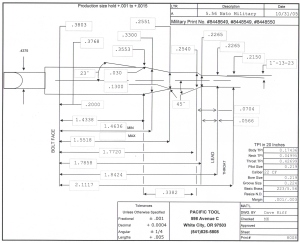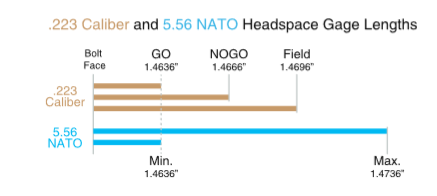The subject of 223 Remington vs. 5.56×45 (5.56 Nato) is a popular source of discussion.
Probably one of the best blog posts on this subject can be found at http://www.luckygunner.com/labs/5-56-vs-223/ or PDF = 556vs223
One item this and most of the discussions seem to overlook is headspace. Since this blog leans more toward gunsmithing subjects, I wanted make sure this subject was discussed. I often hear from clients that the 5.56 and the 223 differ in headspace. The truth is, when I checked the various gauge makers they are all working to the same standard.
Why is this important?
Mainly because educating the shooting public minimizes accidents and makes life easier for all concerned. None of the articles I looked at mentioned headspace. Most of the chamber dimensions being shared do not include headspace dimensions. This may be in part because they are so hard to locate for the 5.56 Nato.
Forster Products publishes the data for their 5.56 gauges. Minimum headspace (Go gauge) is 1.4636” according to their specifications with a tolerance of -.0003”. With the Maximum (Field gauge) measuring 1.4736”; that’s 10/1000s of an inch longer than the go gauge. Most No-go gauges would be set .004” to .006” longer than the Go gauge. The Pacific Tool & Gauge print shown here uses a Go gauge that measures 1.4636”.

Look at the Minimum Headspace dimension listed on this print, it is identical to the dimension used on the 223 Remington.
SAAMI specifications for the 223 Remington show a Minimum headspace (Go gauge) of 1.4636” identical to the military spec for the 5.56×45. The Nato round is not a SAAMI cartridge, so they do not provide prints or specification for it.
My curiosity as to why so many shooters think there is a difference between the gauges for these two, led me to do an Internet search to see what people are reading. I consider all material on the Internet to be of dubious quality until I can confirm the data through trustworthy sources. What I found was interesting; you have to dig deep to find anything that pertains to headspace and the 5.56 Nato.
What is easy to locate are drawings which purport to show why the two cartridges are not the same. The dimensions they are concerned with mostly have to do with the junction of the body and shoulder plus the shoulder and neck. In the real world the camming action of the bolt closing would be more than sufficient to deal with the tiny difference that might exist in the brass. Frankly there is more variation in tolerances allowed than these drawings account for, in short, it’s all smoke and mirrors.
Digging a little deeper, I found a couple of sources that state the Military gauge is .001” longer than is found in the prints mentioned above. Even if that were the case, that is only 1/5th of the difference between a standard Go and No-go gauge for the 223 Remington. To be totally clear, it would make NO difference.
There is a logical reason for commercial gauge makers to set the “Miniumum” or “Go” gauge at 1.4636″. MIL-C-70599A(AR) 20 January 1994 MILITARY SPECIFICATION, CARBINE, 5.56MM: M4 reads on page 9: 3.4.1 Headspace. The headspace shall not be less than 1.4646 inches nor more than 1.4706 inches when measured to the .330 inch datum diameter on the first shoulder of the chamber. Logically, if your are making gauges; by setting the gauges at 1.4636″ you guaranty that headspace will never be less than 1.4643″ without a guerilla being involved in the assembly process. Plus, we all know that semi-auto and full auto guns prefer a little more room to function. At the same time it is within allowed military specifications, a Win, Win! To be totally clear, it would make NO difference.
Here is a clip from the Forster write-up on NATO headspace: Conclusion: Headspace gauges for the 223 Remington and the 5.56 Nato are identical. The differences between the cartridges has to do with case wall thickness and how they are loaded. If you want to shoot either type of ammo in your gun, rechamber it to 223 Wylde. The Wylde chamber is designed to work safely with both types of ammo.
Conclusion: Headspace gauges for the 223 Remington and the 5.56 Nato are identical. The differences between the cartridges has to do with case wall thickness and how they are loaded. If you want to shoot either type of ammo in your gun, rechamber it to 223 Wylde. The Wylde chamber is designed to work safely with both types of ammo.
Military armorers for field grade weapons utilize only the 5.56 Maximum gauge. Why? Because all that matters in the military is that the gun is safe to fire and functional. So, if you use 223 Remington gauges you will ALWAYS be under the Military Maximum.
Note: this post is only about headspace, we are not addressing the differences in pressure from various ammo. This is covered in the LuckyGunner post linked at the beginning of this post. My buddy over at Ultimate Reloader put out his own discussion of this subject as well, you can watch it below:

A .223 no-go gauge is set to 1.4666 and a 5.56 NATO no-go gauge is set to 1.4696. The “go” gauges for these two calibers are identical at 1.4636, but the no-go gauges are .003 difference. A 5.56 NATO chamber will close on a .223 no-go, so I don’t know why you’re saying the two sets are identical.
I am unsure were you acquired your 5.56 NATO no-go length of 1.4696″?
First, the military does not use Go and No-Go or Field. They use Minimum and Maximum dimensions. Minimum length for 5.56 is 1.4636″ This is the same exact length as a Go gauge for a 223 Remington. Maximum for the 5.56 is 1.4736″ which is 4/1000 (.004″) longer than a Field gauge for the 223 Remington.
I have seen gauge sets that break down the Military specification between Minimum and Maximum. These are likely used by the marksmanship unit with match rifles. They are not used by the average armorer.
Suggested reading would include this page: https://www.forsterproducts.com/pdf/catalog/Gunsmithing_Headspace_Gages_Cat82_38-42.pdf
Note, like the title of the post said, ongoing… I did update a few things in the post, check it out.
I purchased the 1.4696” Clymer 5.56 NATO no-go from Brownells when a brand new Colt barrel and bolt I was paring closed on a .223 1.4666” no-go gauge. In further testing, all three of my Colt AR’s closed on the .223 no-go, but not the specific 5.56 NATO no-go that I purchased from Brownells. In my case, the .003” difference between caliber gauges made all the difference. I understand the concept of the min and max range used by the military, but as a civilian shooting for a hobby, my only concern was the safety factor when pairing a new bolt to a new barrel.
Jack, I think you need to re-read all the information in the post. As there is NO issue. You purchased a gauge that matches the SAAMI maxiumum for 223 Remington, I.E. a Field Gauge for 223 Remington is made to that specification. 5.56 Nato Chambers are normally longer than 223 Remington, so all is as it should be, this is all covered in the linked material if not in the post.
Shoot straight and don’t get lost in the weeds.
Look at all the posts in various forums on the internet where folks like me are simply asking about headspacing their new AR build, which is typically chambered in 5.56. They are told by the masses to go out and buy a “go” and “no-go” gauge. Your conclusion starts off saying: “Headspace gauges for the 223 Remington and the 5.56 Nato are identical.”, which indicates folks can go out and buy a “go” and “no-go” in either caliber and expect them to work in either chamber. Your post does not say to get a .223 “field” to act as a 5.56 chamber no-go, because your 5.56 chamber will most likely close on a .223 “no-go”. I personally found your post misleading, and simply wanted to clarify for others who may happen upon your post looking for the simply answer that I was.
I’m not lost in the weeds, I just like to thoroughly research and do things correctly and safely. If a “no-go” gauge for a 5.56 did not exist, Brownelles would not have been able to sell me one made by Clymer. It gave me piece of mind that my new build is correct, because the bolt did not close on the 5.56 “no-go”, like it did on the .223 “no-go”.
I’m sorry, but we’ll have to agree to disagree. Headspace gauges for the .223 and the 5.56 NATO are not identical when compared by name i.e.(no-go, field, etc.), and that distinction should be made.
In a nut-shell, all “distinctions” are addressed in the post and associated linked material. I updated the post to clarify as a result of your questions.
Longer explanation:
Go gauge and Minimum Gauge for both cartridges are identical.
SAAMI sets a Maximum at a shorter headspace than the Military.
This is because in the private sector we are interested in reloading our brass, not to mention that commercial brass normally has a thinner case wall.
The military does not reload, brass is a consumable. Their interest is that in battlefield conditions the weapon functions under a wide variety of circumstances. Longer headspace is desirable for these goals. It allows for many variables in tolerances and dirt that civilians are not often concerned with.
No-Go gauges for 5.56 are a commercial construct. They do not exist in Military specifications. There is only Minimum and Maximum. Note that the No-Go Gauge you site has the same relationship to the Maximum military specification as does a No-Go to a Field gauge for the 223 Remington.
So technically, the Maximum headspace allowed by the military for 5.56 chambers is beyond safe limits if you are using a 223 Field gauge. All that is shown in the graphic at the end of the post taken from the headspace write up from Forster. The only difference is that 5.56 chambers can have more headspace and still be in spec.
Enjoy Life Sir.
Pingback: GunSkins® DIY Finishing Anyone Can Do | GunsmithTalk
The military (Marines) uses go, no go and field gauges. Just saying.
Interesting. Then the Marines would be an exception. Every available published source, i.e. government documents, only refer to minimum and maximum gauges. Naturally, things can change. But headspace is an established, known measurement.
The Marine Corps uses Army manuals but also goes above and beyond the army norm. Yes we use go and nogo gages on all weapon systems.
Please clarify if the gauges you are talking about are marked Min and Max or if they are Go, No-go? There is a difference so I am curious?
The Colt TDP for the 5.56 NATO chamber uses a 1.4646 Go gauge, not the 223 1.4636 go gauge..
Please provide the source for this information.
Also please define your acronym “TDP” which is not commonly used? Thanks.
Technical Data Pack
Even if the Number given here is “gospel”… We are still talking .001″ or 1/1000th of an inch. SAAMI normally provides for .004″ between a Go and a No-Go guage. Further, the 1.4636” specification is tighter than Wolfgar is suggesting. Still a great big Zero in terms of tolerances. I updated the write-up above to reflect this conversation.
No disrespect intended, just the facts.